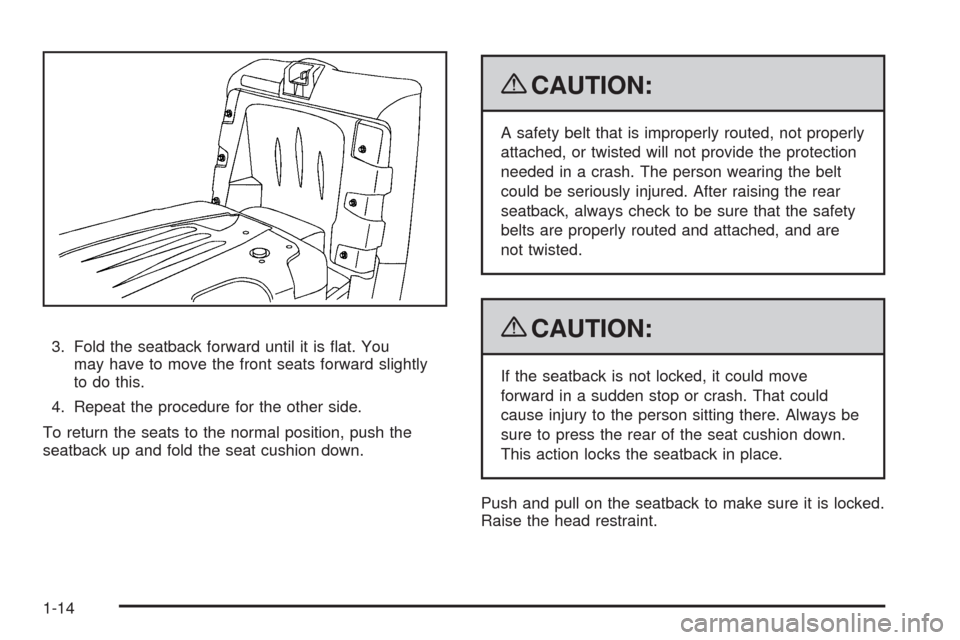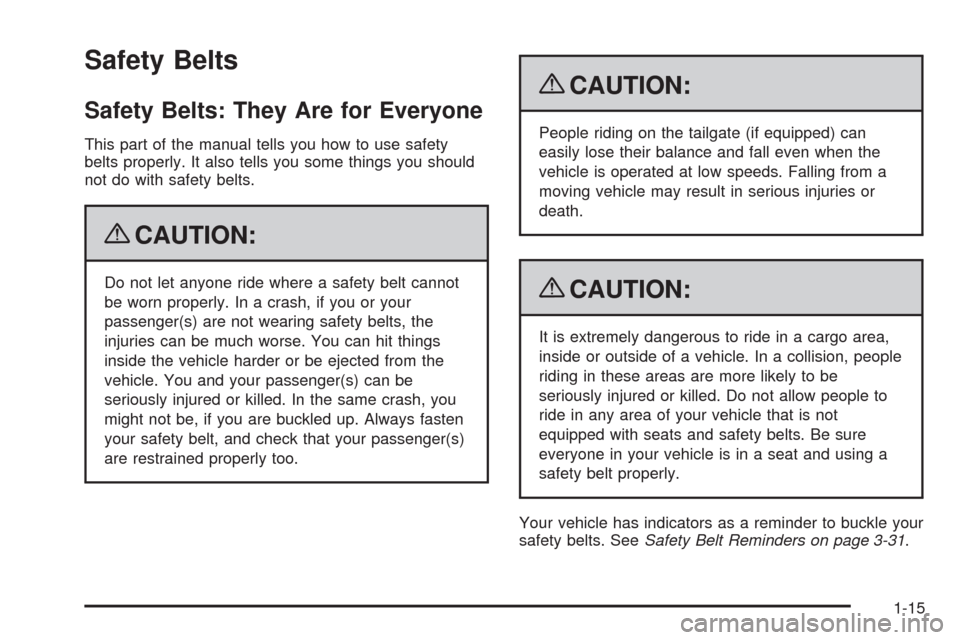2009 CHEVROLET AVALANCHE belt
[x] Cancel search: beltPage 1 of 550

Seats and Restraint System............................. 1-1
Head Restraints
......................................... 1-2
Front Seats
............................................... 1-3
Rear Seats
..............................................1-13
Safety Belts
.............................................1-15
Child Restraints
.......................................1-37
Airbag System
.........................................1-62
Restraint System Check
............................1-78
Features and Controls..................................... 2-1
Keys
........................................................ 2-3
Doors and Locks
......................................2-10
Windows
.................................................2-25
Theft-Deterrent Systems
............................2-28
Starting and Operating Your Vehicle
...........2-32
Mirrors
....................................................2-55
Object Detection Systems
..........................2-58
OnStar
®System
......................................2-66
Universal Home Remote System
................2-69
Storage Areas
.........................................2-76
Sunroof
..................................................2-93Instrument Panel............................................. 3-1
Instrument Panel Overview
.......................... 3-4
Climate Controls
......................................3-20
Warning Lights, Gages, and Indicators
........3-29
Driver Information Center (DIC)
..................3-46
Audio System(s)
.......................................3-76
Driving Your Vehicle....................................... 4-1
Your Driving, the Road, and the Vehicle
....... 4-2
Towing
...................................................4-40
Service and Appearance Care.......................... 5-1
Service
..................................................... 5-3
Fuel
......................................................... 5-5
Checking Things Under the Hood
...............5-12
Rear Axle
...............................................5-45
Four-Wheel Drive
.....................................5-46
Front Axle
...............................................5-47
Headlamp Aiming
.....................................5-48
Bulb Replacement
....................................5-51
Windshield Wiper Blade Replacement
.........5-54
Tires
......................................................5-55
2009 Chevrolet Avalanche Owner ManualM
Page 5 of 550

Vehicle Symbol Chart
Here are some additional symbols that may be found on
the vehicle and what they mean. For more information
on the symbol, refer to the index.
0:Adjustable Pedals
9:Airbag Readiness Light
#:Air Conditioning
!:Antilock Brake System (ABS)
g:Audio Steering Wheel Controls or OnStar®
$:Brake System Warning Light
":Charging System
I:Cruise Control
B:Engine Coolant Temperature
O:Exterior Lamps
#:Fog Lamps
.:Fuel Gage
+:Fuses
i:Headlamp High/Low-Beam Changer
j:LATCH System Child Restraints
*:Malfunction Indicator Lamp
::Oil Pressure
g:Outside Power Foldaway Mirrors
}:Power
/:Remote Vehicle Start
>:Safety Belt Reminders
7:Tire Pressure Monitor
_:Tow/Haul Mode
F:Traction Control
M:Windshield Washer Fluid
v
Page 7 of 550

Head Restraints...............................................1-2
Front Seats......................................................1-3
Manual Seats................................................1-3
Power Seats..................................................1-4
Manual Lumbar..............................................1-5
Power Lumbar ...............................................1-6
Heated Seats.................................................1-7
Heated and Cooled Seats................................1-7
Memory Seat, Mirrors, and Pedals....................1-8
Reclining Seatbacks......................................1-10
Center Seat.................................................1-13
Rear Seats.....................................................1-13
Rear Seat Operation.....................................1-13
Safety Belts...................................................1-15
Safety Belts: They Are for Everyone................1-15
How to Wear Safety Belts Properly.................1-20
Lap-Shoulder Belt.........................................1-29
Safety Belt Use During Pregnancy..................1-35
Lap Belt......................................................1-35
Safety Belt Extender.....................................1-37
Child Restraints.............................................1-37
Older Children..............................................1-37
Infants and Young Children............................1-41Child Restraint Systems.................................1-45
Where to Put the Restraint.............................1-48
Lower Anchors and Tethers for Children
(LATCH)..................................................1-49
Securing a Child Restraint in a Rear Seat
Position...................................................1-56
Securing a Child Restraint in the
Center Front Seat Position..........................1-58
Securing a Child Restraint in the
Right Front Seat Position............................1-59
Airbag System...............................................1-62
Where Are the Airbags?................................1-65
When Should an Airbag In�ate?.....................1-67
What Makes an Airbag In�ate?......................
.1-68
How Does an Airbag Restrain?.......................1-68
What Will You See After an Airbag In�ates?.....1-69
Passenger Sensing System............................1-70
Servicing Your Airbag-Equipped Vehicle...........1-76
Adding Equipment to Your Airbag-Equipped
Vehicle....................................................1-77
Restraint System Check..................................1-78
Checking the Restraint Systems......................1-78
Replacing Restraint System Parts After a
Crash......................................................1-79
Section 1 Seats and Restraint System
1-1
Page 17 of 550

{CAUTION:
Sitting in a reclined position when your vehicle is
in motion can be dangerous. Even if you buckle
up, your safety belts cannot do their job when you
are reclined like this.
The shoulder belt cannot do its job. In a crash,
you could go into it, receiving neck or other
injuries.
The lap belt cannot do its job either. In a crash the
belt could go up over your abdomen. The belt
forces would be there, not at your pelvic bones.
This could cause serious internal injuries.
For proper protection when the vehicle is in
motion, have the seatback upright. Then sit well
back in the seat and wear your safety belt
properly.
Manual Reclining Seatbacks
On seats with manual reclining seatbacks, the lever
used to operate them is located on the outboard side of
the seat(s).
To recline the seatback:
1. Lift the recline lever.
2. Move the seatback to the desired position, then
release the lever to lock the seatback in place.
3. Push and pull on the seatback to make sure it is
locked.
1-11
Page 19 of 550

Center Seat
Your vehicle may have a front center seat. The seatback
doubles as an armrest and cupholder/storage area for
the driver and passenger when the center seat is
not used. Do not use it as a seating position when the
seatback is folded down.
Rear Seats
Rear Seat Operation
The rear seat is a 60/40 split bench seat that can be
folded to give you more cargo space and access to the
folding midgate. SeeMidgate
®on page 2-13for
more information on operation of the folding midgate.To fold either side of the seat do the following:
1. Push the rear seat head restraints all the
way down.
2. Pull the seat loop
located where the
seatback and
seat cushion meet. The
seat cushion will
release and allow you
to tilt it toward the
front of the vehicle.
Notice:Folding a rear seat with the safety belts
still fastened may cause damage to the seat or the
safety belts. Always unbuckle the safety belts
and return them to their normal stowed position
before folding a rear seat.
1-13
Page 20 of 550

3. Fold the seatback forward until it is �at. You
may have to move the front seats forward slightly
to do this.
4. Repeat the procedure for the other side.
To return the seats to the normal position, push the
seatback up and fold the seat cushion down.
{CAUTION:
A safety belt that is improperly routed, not properly
attached, or twisted will not provide the protection
needed in a crash. The person wearing the belt
could be seriously injured. After raising the rear
seatback, always check to be sure that the safety
belts are properly routed and attached, and are
not twisted.
{CAUTION:
If the seatback is not locked, it could move
forward in a sudden stop or crash. That could
cause injury to the person sitting there. Always be
sure to press the rear of the seat cushion down.
This action locks the seatback in place.
Push and pull on the seatback to make sure it is locked.
Raise the head restraint.
1-14
Page 21 of 550

Safety Belts
Safety Belts: They Are for Everyone
This part of the manual tells you how to use safety
belts properly. It also tells you some things you should
not do with safety belts.
{CAUTION:
Do not let anyone ride where a safety belt cannot
be worn properly. In a crash, if you or your
passenger(s) are not wearing safety belts, the
injuries can be much worse. You can hit things
inside the vehicle harder or be ejected from the
vehicle. You and your passenger(s) can be
seriously injured or killed. In the same crash, you
might not be, if you are buckled up. Always fasten
your safety belt, and check that your passenger(s)
are restrained properly too.
{CAUTION:
People riding on the tailgate (if equipped) can
easily lose their balance and fall even when the
vehicle is operated at low speeds. Falling from a
moving vehicle may result in serious injuries or
death.
{CAUTION:
It is extremely dangerous to ride in a cargo area,
inside or outside of a vehicle. In a collision, people
riding in these areas are more likely to be
seriously injured or killed. Do not allow people to
ride in any area of your vehicle that is not
equipped with seats and safety belts. Be sure
everyone in your vehicle is in a seat and using a
safety belt properly.
Your vehicle has indicators as a reminder to buckle your
safety belts. SeeSafety Belt Reminders on page 3-31.
1-15
Page 22 of 550

In most states and in all Canadian provinces, the law
requires wearing safety belts. Here is why:
You never know if you will be in a crash. If you do have
a crash, you do not know if it will be a serious one.
A few crashes are mild, and some crashes can be so
serious that even buckled up, a person would not
survive. But most crashes are in between. In many of
them, people who buckle up can survive and sometimes
walk away. Without belts they could have been badly
hurt or killed.
After more than 40 years of safety belts in vehicles, the
facts are clear. In most crashes buckling up does
matter... a lot!Why Safety Belts Work
When you ride in or on anything, you go as fast as
it goes.
Take the simplest vehicle. Suppose it is just a seat on
wheels.
1-16